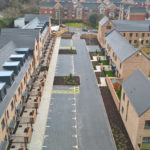Steve Griffiths, Senior Design Manager at Taylor Lane Timber Frame, explains how the flexibility of timber frame enables Registered Providers to meet the demands of the Lifetime Homes Standard and build better quality, future-proof houses.
Building homes is a central driver in the Government’s COVID recovery plan and now, more than ever it is vital that we build homes and communities that are accessible and inclusive. Local authorities and housing associations have an opportunity to future-proof their new-build housing stock.
With build methods, such as timber frame, flexible spaces can be designed-in that can be adapted as and when needed, helping to reduce alteration costs at a later date, facilitate independence and enable residents to live in their homes for longer.
The golden rule with this of course, is to get the timber frame supplier on-board as early as possible; capitalise on their expertise and experience. The design stage is critical for fully realising the benefits of working with timber frame, not least off setting some of the expense of those future alterations.
 Lifetime Homes Standard
Lifetime Homes Standard
Under the Lifetime Homes Standard there are 16 design criteria, timber frame can help councils and housing associations meet the requirement of at least two of these — Criterion 12: Stairs and potential through-floor lift in dwelling and Criterion 13: Potential for future fitting of hoists and bedroom/bathroom relationship.
In response to Criterion 12, the architect and timber frame designer would need to factor in where the through-floor home lift could be installed at a later date. We would recommend setting aside enough room for a lift which can accommodates a carer and wheelchair. Using solid beam trimmers, the timber frame designers can design in a knock-out panel in the first floor — allowing the lift to travel from the ground to first floor (or beyond, if required). Trimming out allows for the lift to be installed without ruining the structural integrity of the first floor.
For Criterion 13, the timber frame provider would need to consider extra loadings when planning for hoists and lifting equipment. If a hoist were to be installed on the top floor of the property, in a bedroom through to a bathroom for instance, the bottom chord of the roof truss (which creates the ceiling) would need to be both wider and deeper in order to accommodate this. Similarly, if a hoist track was required on the ground floor ceiling, the timber frame designer would ensure that the joists used to create the first floor were strong enough to withstand the load.
Good practice recommendations that exceed the requirements of design feature 13 suggest ‘…locate this bedroom and bathroom adjacent to each other with a connecting full height ‘knock out panel’ sufficient to form a direct doorway…’. This can easily be achieved with timber frame. Designers are adept at creating flexible layouts using knock out panels. This design solution can be extremely beneficial when a resident is diagnosed with dementia, for example.

Adaptable living
Dementia affects people in different ways — physical, emotional and psychological, and it can have a dramatic impact on everyday life. Living in a home for longer is not just about the practicalities of access, it is also about familiarity, which is crucial for those suffering with dementia.
While most people with dementia wish to stay in their home for as long as possible, this can’t always be the case, yet moving to a new house after a dementia diagnosis can be challenging. This is where the benefits of a flexible layout come into play. By transforming two adjacent ground floor rooms into a bathroom and bedroom, ideally with access to and/or a view of green space, a person may be able to stay living in their home for longer. This can be achieved with a few tweaks to the timber frame design, including knock out panels in the wall panels.

Room size
The impact on room size is a key consideration when designing adaptable, future-proof spaces. Under the Lifetime Homes Standard movement around a property should be convenient for a wide range of people, including those with mobility aids or wheelchairs. Criterion 6, for example requires wider internal doorways and hallways. This, coupled with the area needed for a through-floor home lift along with sufficient room for a user and potentially, a carer to ingress and egress from the lift, could have a negative impact on the space and potentially hinder movement around the room. It is essential therefore that architects and specifiers look for solutions that allow them to maximise room size without compromising factors such as thermal performance.
Timber frame, for example, achieves a better thermal performance than traditional brick and block, with a slimmer wall make-up. A standard wall constructed using timber frame can achieve a U-value of 0.19W/m2K. A traditional build would usually need a wider wall construction to achieve 0.19W/m2K, with a bigger cavity and more insulation, which would impact on room size.
By thinking ahead, and making some simple adaptations, social housing providers can offer safe and comfortable homes that will suit the changing needs of their residents for many years.
Header image is an aerial photo of a housing development built using Taylor Lane’s timber frame solutions.









